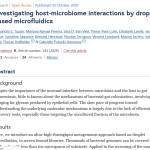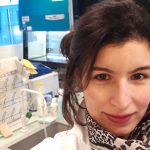MetaFluidics will empower the European (bio)technological industry with a set of biological, microfluidic and bioinformatics tools (toolkit) to increase throughput and lower costs by orders of magnitude, develop new applications, exploit new knowledge and reduce the time from gene discovery to industrially relevant biocatalysts and bioactive molecules at TRL5.
To fully exploit the interdisciplinary character of MetaFluidics, the project is divided into eight work packages (WPs), most of which correspond to the consecutive stages of the metagenomics workflow.
The following sections describe the innovations proposed by MetaFluidics to overcome current limitations.
1. Sampling
To maximize the chances for success and the diversity of enzyme and molecule targets that can be found, the MetaFluidics consortium has access to a wide array of already built metagenome libraries from previous research actions. Among the biotopes previously sampled are off-shore subsurface oil reservoirs, Arctic and Antarctic ice and soil, seawater and marine sludge, microbiota of marine invertebrates, shallow marine and abyssal geothermal areas, hypersaline and/or acidic environments, sites enriched in heavy metals and cow rumen. Access to complementary sampling sites, such as compost piles or marine environments and sand dunes among others, will enable the consortium to construct new libraries that will increase the chance for success in finding relevant genes, enzymes and molecules. A particular novelty of MetaFluidics is the presence of metaviromics expert UA, who will work jointly with the rest of the consortium to mine viral metagenomes (metaviromes), which have not been extensively searched for biotechnologically useful activities so far.
In the case where new libraries need to be constructed the efficient recovery of good-quality environmental DNA (eDNA) is a key step in the metagenomics workflow and MetaFluidics will therefore also address the issues of integrity and yield of the recovered DNA.
2. Enrichment
Generic strategies will be developed to enrich metagenomic libraries in a particular
traits of interest using both in situ techniques, and ex situ techniques at TRL3-4.
In situ enrichment in extreme environments will be sampled at TRL4 using “bacterial traps”.
Ex situ enrichments will be based on the unprecedented throughput of droplet microfluidics as well as the use of flow cell devices for biofilm growth and enrichment.
Using the above mentioned approaches, metagenomic libraries will be enriched for individual members with certain 16S rRNAs, representing microbial taxa of interest.
3. Library construction and heterologous expression
MetaFluidics will implement new broad range vectors and hosts as well as expression in droplets.
4. Library screening
In MetaFluidics, the metagenomic diversity will be screened to target relevant sectors of the bioeconomy, namely biofuels, agriculture and bioremediation, biocatalysis for functional food ingredients, fine chemicals and API synthesis as well as the discovery of pharmaceutically relevant molecules.
MetaFluidics will base its screening effort on novel droplet microfluidic systems and enable ultrahigh-throughput screening (107 /hour) based on the miniaturization of the reaction to droplets with picoliter volumes.
MetaFluidics will increase the scope of droplet-based screening by developing additional detection modes.
5. Hit characterization
When libraries are screened for enzymes, the most original hits (in terms of sequence and catalytic potential) will be sequenced, cloned and expressed in a wide range of microbial hosts to identify the optimal expression system. Selected new activities will be functionally and structurally characterized to evaluate biotechnologically important properties and to establish structure-function relationships for the most original protein families. Biochemical characterization may also be carried out in droplets, using microfluidic technology.
6. Sequencing and data analysis
MetaFluidics aims to develop a user-friendly and multi-platform, beyond the state-of-the-art bioinformatics tools,



